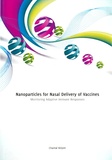Nanoparticles for Nasal Delivery of Vaccines
Monitoring Adaptive Immune Responses
Summary
The continuous emergence of new pathogens and growing drug resistance of microorganisms asks for innovative vaccination strategies. An alternative to conventional multiple injection vaccines is the nasal route of vaccine delivery. The immune response induced following nasal antigen delivery depends on many factors, such as the nature of the antigen, the formulation (soluble versus particulate), antigen size, dose and frequency of administration. Although nasal antigen delivery might be a cost effective innovative vaccination strategy, the physiology of the nasal cavity, including mucociliary clearance and the inefficient uptake of soluble antigens by nasal epithelial cells limits the efficacy of nasal vaccines. Therefore, nasal vaccines often require potent adjuvants and/or vaccine delivery systems that enhance their immunogenicity and delivery to the mucosal tissues. The research described in this thesis aims to unravel adaptive immune responses induced after nasal administration of several particle-based vaccines that can either induce protective immunity or tolerance. Previous studies showed that non-living bacterial like particles (BLPs) that are derived from the food grade bacterium Lactococcus lactis are effective stimulators of local and systemic immune responses when administered intranasally. Moreover, in vitro, BLPs specifically interact with human toll-like receptor 2 (TLR2), suggestive of a role for TLR2 dependent immune activation by BLPs. Chapter 2 describes the role of TLR2, in vivo, in BLP-dependent activation of local and systemic virus-specific immune responses after nasal administration of BLP mixed with split influenza vaccine in TLR2 knock-out mice. In addition to BLP particles, we also investigated the effects of the synthetic poly-lactic-co-glycolic-acid (PLGA), poly-lactic-co-glycolic-acid N-trimethyl chitosan (PLGA-TMC) and N-trimethyl chitosan tripolyphosphate (TMC-TPP) nanoparticles. There is at the moment very limited knowledge about the capacity of nanoparticles to modulate the immunological outcome after nasal vaccination. Chapter 3 describes the mechanism behind nasal nanoparticle vaccination, the characteristics of three nasal vaccine delivery particles composed of PLGA, PLGA-TMC and TMC-TPP are correlated to their capacity to induce antibody production. Chapter 4 continues with the characteristics of the PLGA, PLGA-TMC and TMC-TPP nanoparticles and their capacity to activate CD4+ T-cells locally and systemically. We also investigated the capacity of PLGA, PLGA-TMC and TMC-TPP nanoparticles to differentially regulate the immune response by characterizing CD4+T-cell differentiation and the ability to induce mucosal tolerance. In Chapter 5 we explored, in vitro, if PLGA nanoparticles compared to TMC-TPP nanoparticles trigger dendritic cells to acquire retinoic acid (RA) producing capacity to induce FoxP3+CD4+T-cells via a TGF-β and RA dependent mechanism. In Chapter 6, the role of heat shock proteins as therapeutic targets in autoimmune diseases and other chronic inflammatory conditions is reviewed. Finally in Chapter 7, the findings described in this thesis are summarized and discussed in the context of recent developments in the research on mucosal applied vaccine delivery particles and adjuvants. Potential future research directions are indicated, which may resolve unanswered questions concerning the application of nasal vaccines. This will give further insight in the mechanism of how nanoparticles and adjuvants operate and how they can be used to modulate mucosal immune responses.
